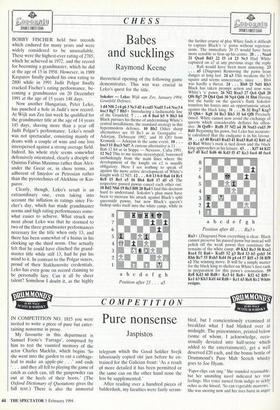4 4 " ,(6:01EICIIR3 CHESS
SPAIN'S FINEST CAVA
11P43 WI au I
N'S FINEST CAVA SPAT
Babes and sucklings
Raymond Keene
BOBBY FISCHER held two records which endured for many years and were widely considered to be unassailable. These were the highest-ever rating of 2785, which he achieved in 1972, and the record for becoming a grandmaster, which he did at the age of 15 in 1958. However, in 1989 Kasparov finally pushed his own rating to 2800 while in 1991 Judit Polgar finally cracked Fischer's rating performance, be- coming a grandmaster on 20 December 1991 at the age of 15 years 148 days.
Now another Hungarian, Peter Leko, has punched a hole in Judit's new record. At Wijk aan Zee last week he qualified for the grandmaster title at the age of 14 years 145 days, shaving more than a year off Judit Polgar's performance. Leko's result was not spectacular, consisting mainly of draws with a couple of wins and one loss interspersed against a strong average field. Indeed, his whole style seems somewhat defensively orientated, clearly a disciple of Quintus Fabius Maximus rather than Alex- ander the Great or, in chess terms, an adherent of Smyslov or Petrosian rather than the pyrotechnics of Alekhine or Kas- parov.
Clearly, though, Leko's result is an extraordinary one, even taking into account the inflation in ratings since Fis- cher's day, which has made grandmaster norms and high rating performances some- what easier to achieve. What struck me most about Leko was that he stormed to two of the three grandmaster performances necessary for the title when only 13, and there has been somewhat of a hiatus in his clocking up the third norm. One actually felt that he could have clinched the grand- master title while still 13, had he put his mind to it. In contrast to the Polgar sisters, proud of their Stakhanovite credentials, Leko has even gone on record claiming to be personally lazy. Can it all be sheer talent? Somehow I doubt it, as the highly
theoretical opening of the following game demonstrates. This win was crucial in Leko's quest for the title.
Sokolov — Leko: Wijk aan Zee, January 1994; Grunfeld Defence.
1 d4 Nf6 2 c4 g6 3 Nc3 d5 4 cxd5 NxdS 5 e4 Nxc3 6 bxc3 Bg7 7 Bb5+ Introducing a fashionable line of the Grunfeld. 7 . . . c6 8 Ba4 b5 9 Bb3 b4 Black pursues his theme of undermining White's central installations, the standard strategy in this hypermodern defence. 10 Bbl Other sharp alternatives are 10 Be3 as in Georgadze Adorjan, Debrecen 1992, and 10 Qf3 from Kramnik — Adorjan in the same event. 10 . . . bxc3 11 Bxc3 Nd7 A curious alternative is 11 . . . Ba6 12 h4 as in Soppe — Neverov, Cuba 1991. 12 Net This to me seems stereotyped, borrowed unthinkingly from the main lines where the development of the knight on e2 is usually obligatory. Here I see nothing to speak of against the more active development of White's knight with 12 Nf3, 12 . . . 0-0 13 0.0 Ba6 14 Rcl Rc8 15 Rel e5 16 Bb4 Re8 17 d5 c5 The respective passed pawns cancel each other out. 18 Bd2 Nb6 19 Be3 Bf8 20 Ba4 I find this decision hard to understand. Sokolov's plan must have been to increase his attack against Black's split queenside pawns, but now Black's queen's bishop sinks itself into the white camp, while in the further course of play White finds it difficult to capture Black's 'a' pawn without repercus- sions. The immediate 20 f3 would have been more sensible to firm up his centre. 20 . . . Nxa4 21 Qxa4 Bd3 22 f3 c4 23 Nc3 Had White captured on a7 at any previous stage the reply . . . Ra8 would have been most annoying. 23 . . . a5 (Diagram) Removing the pawn from danger at long last. 24 a3 This weakens the b3 square and seems unnecessary, since . . . Bb4 was hardly a threat. 24 . . . Rb8 25 Ndl Rb3 Black has taken prompt action and now wins White's 'a'pawn. 26 NI2 Rxa3 27 Qc6 Qa8 28 Q16 Bg7 29 Qh4 Qa6 30 Ng4 Qd6 31 Bh6 Having lost the battle on the queen's flank Sokolov transfers his forces into an opportunistic attack against the black king. 31 . . . f6 32 Bxg7 Kxg7 33 Qh6+ Kg8 34 Re3 Rb3 35 h4 Q18 Precisely timed. White cannot now avoid the exchange of queens which considerably deflates his offen- sive. 36 Qxf8+ Rxf8 37 Nf2 a4 38 Nxd3 cxd3 39 Rdl Regaining his pawn, but Leko has accurate- ly calculated that the endgame is in his favour. 39 . . . a3 40 Rexd3 Rxd3 41 Rxd3 Ra8 42 Rdl a2 43 Ral White's rook is tied down and the black king approaches at his leisure. 43 . . . Kf7 44 Kf2 Ke7 45 Ke2 Kd6 46 Kd3 f5 47 Kc3 fxe4 48 fxe4 Position after 48 . . Ra3+ Ra3+ (Diagram) Now everything is clear. Black cannot preserve his passed pawn but instead will polish off the weak pawns that constitute the remains of the white camp. 49 Kb2 Re3 50 Rxa2 Rxe4 51 Ra6+ KxdS 52 g3 Rc4 53 h5 gxh5 54 Rh6 Rc7 55 Rxh5 Kd4 56 g4 e4 57 R15 e3 58 Rf8 e2 The winning move. It will he a simple matter for the black king to shelter on White's first rank in preparation for this pawn's coronation. 59
Kd3 60 Rd8+ Ke3 61 Re8+ Kf2 62 RN+ Kel 63 Kb3 Kd1 64 Rd8+ Kcl 65 Re8 Rc2 White resigns.


















































 Previous page
Previous page